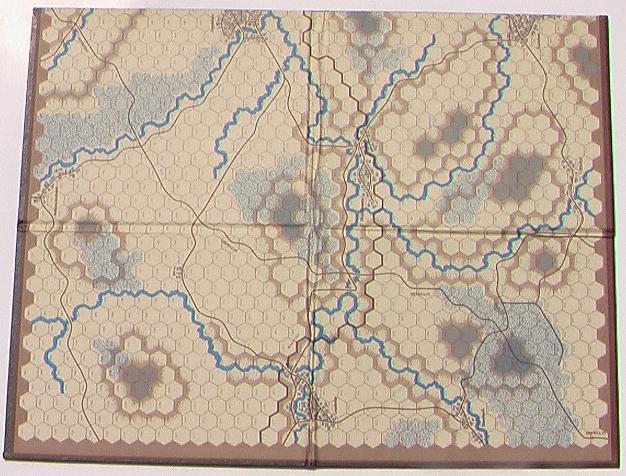Mech War '77
Tactical Armored Combat in the 1970's
SPI
(Simulations Publications, Inc.) 1975 - # HMW-773
From the Box:
The Course of the Battle... The initial surprise Soviet invasion of Germany came through the Fulda Gap to the northeast of Wurzburg, and the Hoff Gap to the east. The U.S. 2nd Armored Cavalry Regiment was given the taskof screening the entire southern flank of the Soviet breakthrough at Fulda. Strung from Gemunden to Schweinfurt, the regiment's 2nd Squadron was to hold advance elements of the Soviet First Guards Tank Army from penetrating the Werneck River line. It had been in contact with Soviets on the prior day north of Schweinfurt. Night patrols and early air reconnaissance confirmed that soviets were stacked up all along E70 and Route 19, with the lead elements poised along Route 26a.
These units were the Soviet 601st Reconnaissance Battalion, closely followed by the 2nd Battalion/229th Tank Regiment/19th Tank Division, plus attached support. The Soviet units succeeded in pushing back these U.S. units; but other Soviet offensives, driving toward the west in the area of Hammelburg, were contained.
With a new front between Bergtheim and Volkach blocking the southern advance of the Soviets, the Soviet 170th Motorized Rifle Regiment/57th Guards Motorized Rifle Division began to move through Schweinfurt and down the Wern River Valley, toward Arnstein and Karlstadt, thus threatening to envelop the newly-established U.S. line.
Available to oppose this thrust was a troop of the 1st Battalion/2nd Armored Cavalry Regiment, located at Arnstein, and an ersatz airmobile task force of the 3rd Mechanized Infantry Division, in Karlstadt. Repulsed by these U.S. forces, the Soviets were once again forced to turn their attention to the south.
The 2nd Brigade of the 3rd Mechanized Infantry Division held the Wern River line. The Soviet 57th Guards Motorized Rifle Division was given the task of clearing the way to Wurzburg. Striking the U.S. flank, held by the 2nd Battalion/15th Infantry Regiment, was the job of the 170th Motorized Rifle Regiment. This time, the Soviet assault was successful, and the 172nd Motorized Rifle Regiment was sent forward to exploit the gains made by the 170th. Its pursuit of the 2nd/15th continued to the very outskirts of Wurzburg, while the remnants of the 170th were given the task of consolidating against a U.S. counter-attack from Arnstein. This counter-attack, made by units of the U.S. 1st Armored and 15th Infantry Divisions, failed to relieve the pressure on Wurzburg, which subsequently fell under the weight of renewed Soviet assaults. The Soviets then regrouped and pressed on toward the Rhine. But finally, NATO forces went over to the counter-offensive along the entire front, desperately trying to halt the Soviets and destroy their offensive capability.
These Situations, and others are depicted in Mech War '77.
The Course of the Game... This game is a simulation of hypothetical events. It is played on a map showing a typical section of open country in north-western Europe. which allows numerous different situations to be simulated. A grid of hexagons printed over the map is used to regulate movement much as the squares on a chess board. The pieces in the game represent the various miliatry unit types now current in the armies based in Europe. The large numbers on the pieces indicate the releative strengths and abilities of these units. Each player maneuvers his pieces on the map in turn; then the units of both sides may simultaneously fire when within range of their targets. The total relative strengths of the involved units are compared. The attacking player consults a simple probability table (the Combat Results Table) to determine the effectiveness of the fire. The game proceeds this way (for a specified number of turns) as the players try to achieve the objectives set forth in the rules. No prior knowledge of history or military tactics is required to play the game - just a little ingenuity and common sense.
Number
of Players and Age Range: Two players; 12 years through adult
Average Playing Time: 4.5 hours
Complexity Rating: 6.6 Acceptabiity Rating 7.1 (on a scale of 1
to 9 with 9 being most complex or highly acceptable)
-
Game Box
-
One 22" by 34" mounted terrain map (2 seperate fold out pieces)
-
400 Die Cut Counters
-
Rules folder
-
Two sheets of charts and tables
-
Plastic Storage Tray
-
One Plastic Die
-
Errata sheet explaining how to set up the map boards
Game Parts:
Box Front
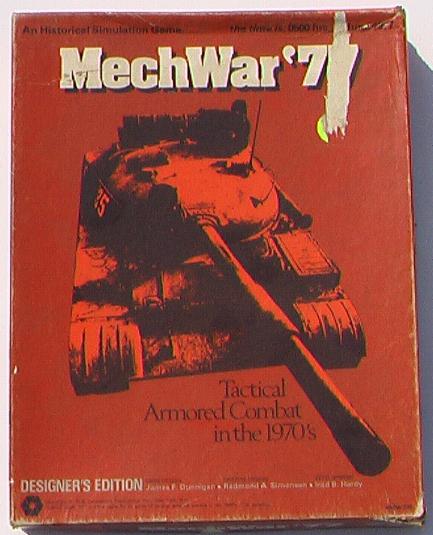
Box Back
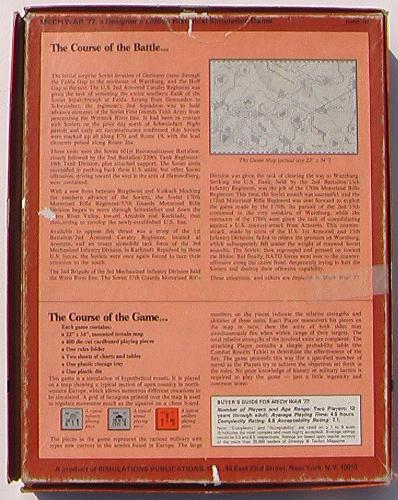
Plastic Storage Tray and Counters
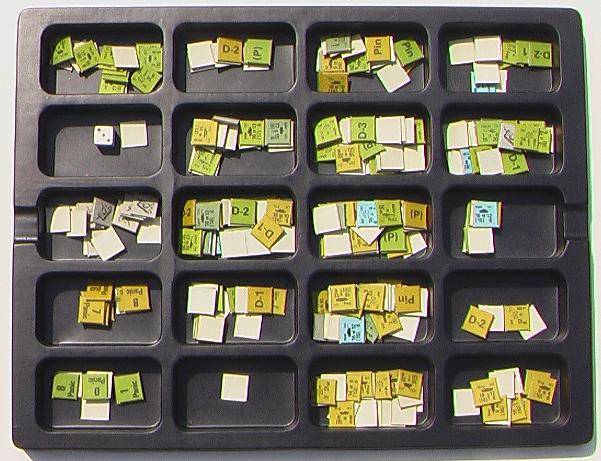
More Counters
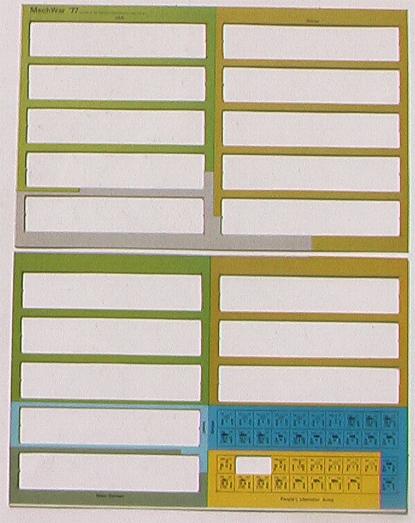
Rules book
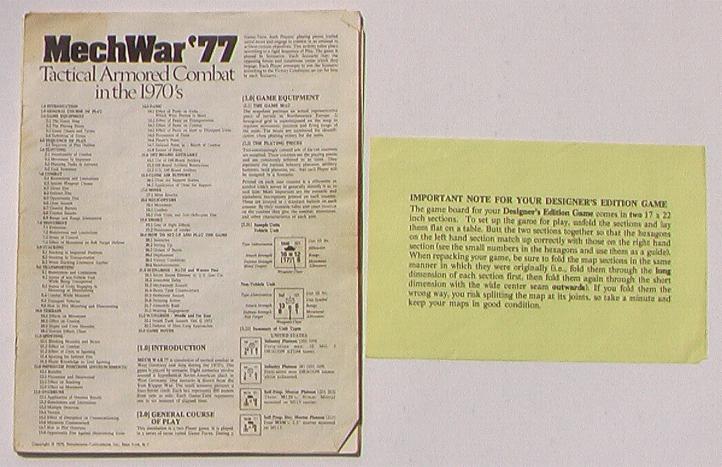
Map board #1
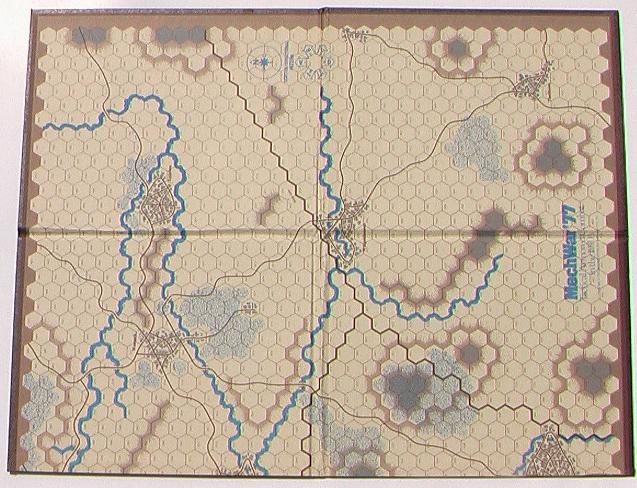
Map board #2
